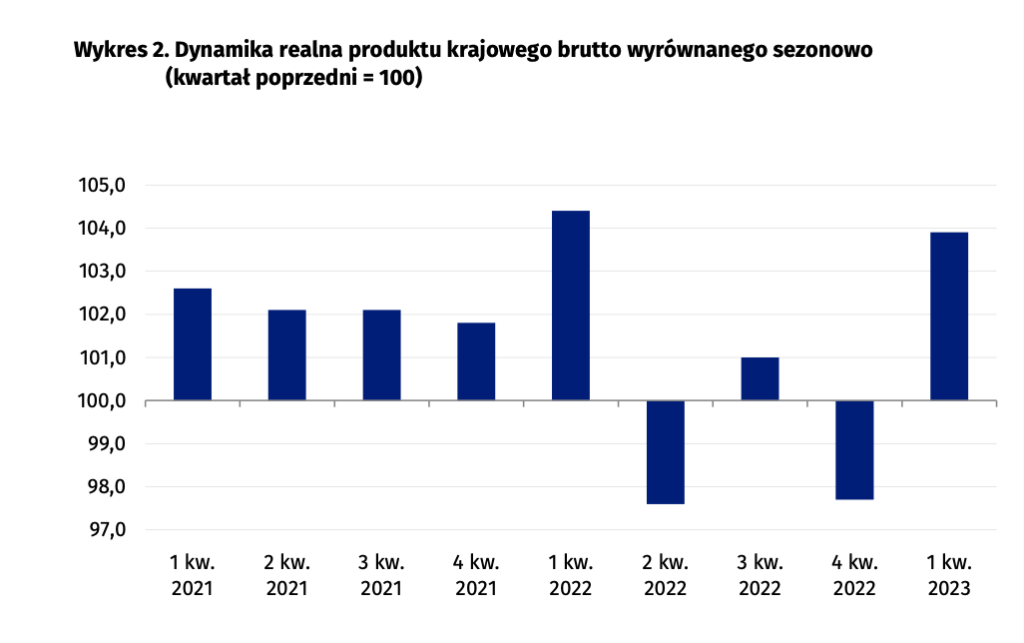Preliminary estimates of Poland’s GDP for the first quarter of 2023 have been published by the Central Statistical Office, and the resulting information brings some surprise. According to the data, Poland’s GDP in annual terms decreased by 0.2%. However, despite appearances, this information is optimistic.
What is GDP?
The modern economy is based on the measurement and analysis of various indicators that help us understand the condition and dynamics of a country’s development. One of the most important indicators is the Gross Domestic Product (GDP), which is an integral part of the tools of economists, analysts and policy makers. GDP is the total monetary value of all goods and services produced in a country, usually over a year or quarter. It is the sum of the value added generated by all economic entities in a country, regardless of who owns them.
Nominal GDP. GDP expressed in current market prices. This is the value of production and services expressed in current prices that are prevailing in the market in a given period.
Real GDP. It is calculated in constant prices of a selected period, for example, in the prices of
a certain year. Real GDP takes into account price changes that occur between consecutive years. It is also often called “real output”, because it reflects the total production of goods and services in the economy, regardless of price fluctuations.
Potential GDP. This is the maximum value of output that an economy can achieve with stable prices and under conditions of full employment of resources. The level of potential GDP depends on the productive potential of the economy, which is derived from the available resources of labor, capital and land. It is an indicator that reflects the theoretical level of output that an economy can achieve according to a growth model. In practice, however, actual GDP may deviate from potential GDP due to temporary economic fluctuations. However, once the fluctuations stop, the economy usually returns to its potential output level.
Why is the decline in Poland’s GDP perceived as good news?
The reason is that the market expected a much deeper decline – it suggested that Poland’s GDP would contract by 0.8%. Therefore, the lower-than-expected decline has a favorable impact on the country’s economic outlook for the current year. It is worth noting that despite the year-on-year decline in GDP, there was solid growth in quarter-on-quarter terms. Indeed, Poland’s GDP in the first quarter grew by an impressive 3.9% compared to the fourth quarter of 2022, while the market consensus (median forecasts of analysts or economists gathered by a news agency) was for only 0.7%. This is therefore an extremely surprising result.
- The spirit of the Polish economy revealed itself again in the data. Great results for Q1. Barely a 0.2% decline in GDP on an annualized basis. A firecracker in seasonally adjusted terms (+3.9% q/q). The technical recession is over. The economy is entering a recovery phase, as confirmed by economic indicators – mBank Research [1].
The first estimates of Poland’s GDP in the first quarter of 2023 give hope for an economic rebound and indicate that our economy is more resilient than expected. Despite inflationary difficulties, achieving such quarterly growth is a positive sign for the future. Of course, further monitoring and analysis of the data is needed.
- The data are preliminary and may be subject to revision, in accordance with the revision policy used in the quarterly national accounts, when the first regular estimate of GDP for Q1 2023 is compiled, which will be published on May 31, 2023. – Central Statistical Office [2].

GDP – key to success or a fad?
GDP is not just a number, but also a snapshot of a country’s history that expresses the value of all goods and services produced in a given period. It is a spectrum of economic activity – from industrial production to services, from agriculture to the financial sector. GDP is key to understanding the overall size of an economy and its potential. One of the main uses of GDP is to monitor economic growth. It’s a tool that allows us to assess a country’s growth rate and compare it with others. GDP growth means increased production and national income, which can improve the quality of life for citizens. A slowdown in GDP, on the other hand, can signal problems in the economy and the need to take appropriate action.
Bibliography:
[2] Główny Urząd Statystyczny, Szybki szacunek produktu krajowego brutto za 1 kwartał 2023 r., https://stat.gov.pl/obszary-tematyczne/rachunki-narodowe/kwartalne-rachunki-narodowe/szybki-szacunek-produktu-krajowego-brutto-za-i-kwartal-2023-roku,1,41.html
Zuzanna Czernicka


